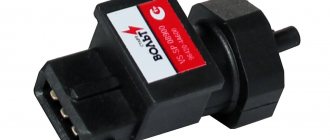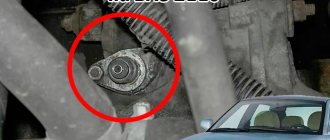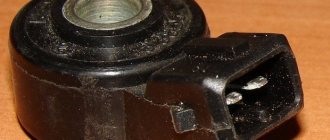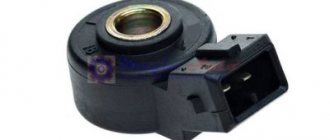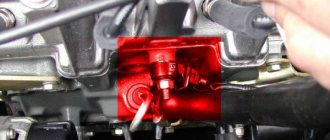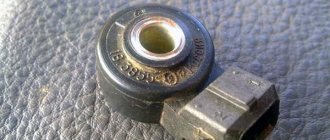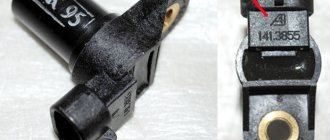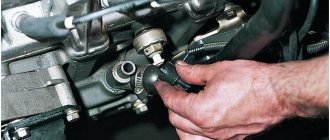During operation of the VAZ 2110 power plant, detonation may occur. It has an extremely negative effect on the engine, not only creating vibration, but also having a destructive effect on the cylinder-piston group.
Damage accumulates in the engine and this brings the need for a major overhaul of the power unit closer. The electronic engine control unit is capable of eliminating detonation. For it to work correctly, the module must receive information from the DD in real time. Depending on the data received, the ignition timing changes and detonation is eliminated.
Checking the functionality of the sensor
Do not rush to throw away the old sensor - first you should check its functionality.
Often the problem lies in faulty wiring, in which case replacing the sensor will not help. To test the knock sensor, you should connect it to a multimeter, setting the latter to test DC current. When hitting the sensor, the multimeter should show a voltage of about 15–30 mV. The more intensely you hit it, the more voltage it should generate. If the multimeter shows nothing when hitting the sensor, then it definitely needs to be replaced.
If you notice even a slight manifestation of a sensor malfunction, it is necessary to diagnose the vehicle. But often, when a single error occurs, the malfunction icon on the dashboard is constantly lit, although there are no other signs of a sensor malfunction - in this case, it is enough to reset the computer errors.
We will answer your questions for FREE regarding deprivation of rights, road accidents, insurance compensation, driving into the oncoming lane, etc. Daily from 9.00 to 21.00
Moscow and Moscow region
St. Petersburg and Leningrad region
Free call within Russia 8-800-350-23-69 ext.418
Knock sensor malfunction during operation
Where is the VAZ 2110 speedometer sensor located? Where is the speedometer sensor located?
To identify faults in the knock sensor, you need to know where it is located in the power compartment of the car. Its location is not far from the oil dipstick at the top of the cylinder block.
Sometimes the defect can be eliminated by simply tightening or loosening the fastening of the product to the motor; the tightening force should be within 20 Nm. It is better to control the tightening force of this type with a special torque wrench. If the adjustment does not have a positive effect, it is necessary to check the VAZ 2110 knock sensor and then replace it with a new product.
The search for faults in the knock sensor must be carried out on a special stand, which is equipped at service stations or repair plants. At home, you can try to repair the VAZ 2110 knock sensor if you have basic concepts in electrical engineering and the car enthusiast can use a tester or similar device with millivoltmeter and megohmmeter scales.
The procedure for determining a malfunction of the knock sensor is as follows:
- Before checking the knock sensor, it must be removed from the power unit. To do this, you need to press the latch and disconnect it from the contact block.
- Unscrew the fastening nut and dismantle the product by removing it from the stud.
- To diagnose a removed device, you need to power it to the terminals of the multivoltmeter, setting the minimum measurement limit.
Important: you should know that for a knock sensor with one contact, the black wire, which is associated with the negative contact, is connected to the mounting bolt socket, and the positive red wire must be connected to the signal contact in the shoe connector
Dismantling
First you need to find the sensor. It is located on the left side of the engine, where the line is half of the cylinder block. Next to it is the air filter.
To determine the malfunction or its absence, it is necessary to remove it in the following sequence:
- Disconnect the car from power by removing the negative terminal from the battery;
- Disconnect the block with wires from the contacts of the knock sensor. To do this, press the latch;
- Unscrew the nut securing the device and remove it from the mounting stud.
Please note that during further installation or replacement you will need a torque wrench (tightening force should be 20 Nm).
How to change a knock sensor
Insufficient coolant level sensor in the expansion tank - check and replacement
The knock sensor for VAZ 2110, 2112 and 21214 with a fuel injection system is located in the front of the engine. If the engine has 8 valves, then the sensor is installed in the area of cylinder 4, if there are 16 valves, then between cylinders 2 and 3. On Grant, Priora and Kalina cars it is also located on the engine block between the cylinders.
Replacing it will take no more than 10-15 minutes:
- Unscrew the bolt holding it to the engine block.
- Disconnect the sensor from the terminal block. Remove the sensor and replace it with a working one.
- When installing a new sensor, carefully tighten the mounting bolt - unstable contact with the engine body will lead to errors in the operation of the motor.
Final result
Finally, a few words about installing the sensor after checking it. Remember that the metal surface of the sensor must be clean and free of debris and/or rust. Clean this surface before installation. Similarly with the surface on the sensor seat on the engine housing. You also need to perform preventative cleaning. The sensor contacts can also be lubricated with WD-40 or its equivalent for preventive purposes. And instead of the traditional bolt with which the sensor is attached to the engine block, it is better to use a more reliable pin. It secures the sensor more tightly, does not loosen the fastening and does not unwind over time under the influence of vibration.
Consequences of a malfunction
How to check the crankshaft sensor of a VAZ 2115 injector 8 valves
If you notice the Check Engine icon on the dashboard, you should immediately visit the nearest service station for diagnostics. Often, the car’s on-board computer reports error p0325, which means a malfunction of the knock sensor circuit 1. The cause of its occurrence can be either an open circuit or possible errors in the knock sensor. In the first case, it is enough to check the sensor connector - if it was not completely latched during the previous replacement, then over time it may open.
Failure to take corrective action on a faulty knock sensor may result in more serious damage:
- strong vibrations and shocks will eventually lead to the destruction of the piston;
- the engine will begin to get very hot, which is fraught with boiling of the coolant with all the ensuing consequences. At best, you will have to spend money on a major overhaul of the engine, but often the block is destroyed by a broken connecting rod;
- increased fuel consumption. An additional symptom of this is the appearance of strong smoke from the exhaust pipe with a distinct smell of gasoline;
- reduction in engine power. A significant deterioration in dynamics can lead to an emergency on the road.
If such a breakdown occurs, repairs should be started without delay. If there is a malfunction, it is better to replace the knock sensor in a timely manner than to pay for repairs in the future, the cost of which may increase by an order of magnitude.
Main purpose of the device
A very unpleasant phenomenon is natural explosions in a car engine, which can be caused by uncontrolled and completely spontaneous combustion of diesel fuel. This process takes place in the fuel chamber. But the knock sensor installed in the engine system of a VAZ 2112 or 2110 vehicle controls this process.
Moreover, this device establishes this fact at the initial stage of the process, transmitting the relevant information to the main unit. But the ECU automatically corrects the ignition timing process in order to prevent undesirable consequences. This is how the knock sensor works in the old-style VAZ 2110 car and the newer model installed in the VAZ 2112.
Replacing the Priora Knock Sensor 16 Valves AUTOINTERLINE.RU
The main symptoms of a faulty knock sensor on a VAZ-2112 16 valves
The knock sensor on the 16-valve VAZ-2112 has the same malfunction conditions as some GAZ, Toyota, Gazelle, Priora and Kalina cars. We change the knock sensor ourselves. Detailed article about replacing the temperature sensor, replacing the VAZ-2112 sensor 16 valves. 2. Replacing the knock sensor. 16:23. New. Naturally, not every motorist will be able to find out that this is exactly the sensor, but you can discern the direct and indirect reasons for the malfunction.
The video provides an overview of the main faults and diagnostics of the wide-band knock sensor on the VAZ-2112:
Signs of a malfunctioning knock sensor
Resistance that should be in the sensor in good condition
Before considering the causes, it is necessary to look at the symptoms of the malfunction. So, let’s look at what can still serve as a warning sign that the knock sensor has failed:
- The engine loses power.
- Overclocking potential drops.
- Fuel consumption has increased.
- The CHECK light came on on the instrument panel.
- Smoky exhaust.
- Presence of detonation.
- The engine started to stall.
Of course, an important reason for the failure of the knock sensor is the fuel mixture, namely the quality of gasoline itself. The lower the octane number, the lower the resistance to detonation
phase sensor 2110, 2111, 2112 16kl. Where is the phase sensor located? Error p0340. Replacing the camshaft position sensor on a 16 valve engine. If the fuel detonates, it will not completely burn through the engine and you will hear the muffler firing.
Replacing the knock sensor on a Lada Priora.
Replacing the KNOCK sensor. Error P0325.
Happy everyday life of an AvtoVAZ owner: driving and repairing, driving and repairing. Replacing the knock sensor on a VAZ-2112 16 valves: photos and. Signs of a malfunction of the knock sensor VAZ-2112 16 valves. We change the knock sensor.
Knock sensor diagnostics
The sensor is checked with a multimeter. Replacing valves on a Priora 16 valves. In this case, the sensor is “knocked” with a screwdriver
To diagnose the knock sensor, it is removed from the engine and a voltmeter with a measurement limit of up to 200 mV is connected to it.
Next, they “knock” the sensor on a hard surface and look at the voltmeter readings. When tapping, the readings should change. If they do not change, this means that the sensor is not working. If they change, then the sensor readings change, but whether they are correct is in question!
ECU signal about malfunction
Failure of the sensor will be immediately obvious by a characteristic knocking sound. Many motorists simply reset the “minus terminal” to reset the readings of the electronic control unit, but it is worth understanding the very reasons for the effect and eliminating them. Replacing the timing belt. Priora 16 valves. Let's look at the ECU error codes that signal a failure of the knock sensor:
code-0325 hints at network problems. Replacing the phase sensor for a VAZ 2112 16 valves. Replacing the timing belt: Priora 16 valves. For example, a break in the wiring or acidification of the plug contacts. In this case, we call the electrical circuit connecting the sensor, clean the electrical contacts;
Error 0325 on the BC STATE screen (Open circuit of the knock sensor)
Type of knock sensor
conclusions
It is quite easy to determine the malfunction of the VAZ-2112 16 valve knock sensor. The first sign will be the presence of errors in the electronic engine control unit and the “Check Engine” light on the instrument panel. Next, a simple check with a multimeter will show whether this particular product has actually failed or not. If the sensor is faulty, it must be replaced.
Source
SIGNS OF BREAKAGE
The knock sensor of the VAZ 2114 is a device on the serviceability of which the overall performance of the engine of the fourteenth depends. If the sensor fails, you will notice the following changes in the operation of the car:
- The engine will start to stall at idle;
- Acceleration dynamics will worsen;
- Gasoline consumption will increase;
- At the time of acceleration and when moving off the car, the “Check Engine” indicator will light up on the dashboard.
Also, if the DD is faulty, errors 0327/0326, 0328 or 0325 begin to appear on the on-board computer of the fourteenth.
Error No. 0325 indicates problems with the wiring supplying power to the sensor; it may break or become oxidized. Actual wire breakage is usually quite rare, so in most cases the problem is oxidation of the contacts.
In addition to a failed DD, error 0325 may indicate a slipped timing belt, so if cleaning the contacts does not work, check the belt.
Errors 0326 and 0327 occur when the brain of the car (ECU) with the DD receives an insufficient power signal. Here, again, the problem may be either in the device itself or in the contacts. It is also possible that the cause of the low signal is poor tightening of the DD in the mounting socket.
Check how tight the DD is
How to check
If a component breaks down, the car will continue to function as before. There may not be any obvious symptoms of a malfunction. If a breakdown occurs, it will be considered electronic, since the device is part of the car’s electronics.
Device failure can occur for a variety of reasons - for example, due to a malfunction of the device itself, a short circuit in the system, or a break in the signal wire. To conduct self-diagnosis, you need to determine where the sensor is located. The car's owner's manual has information about this.
Next we begin to remove the mount. Unscrew the nut on the stud. Disconnect the electrical connector and put it aside. The body of the device is removed from the pin. The knock sensor is checked using two wires - signal and ground. Remember that there is a fragile piezoelectric crystal inside the device. Of course, the system provides certain protection in the form of compensators, but it will not save you from strong mechanical impact. It is not worth disassembling the sensor, since the seal of the housing must not be violated.
It's better to check with a multimeter. There should be no twists on its wires. It is better to use a device with short wires. The minus probe is connected to the sensor hole located in the center, and the positive probe is connected to the control connector. If the device is working properly, the multimeter indicator will show a jump in electricity of 40-150 mV.
If the device is faulty, there will be no activity. You can check with several devices - then there will be no doubt that the procedure was carried out correctly. After diagnosis, the defective sensor is replaced.
If the sensor does not work, it must be replaced - there are no other options here. The device is inexpensive and can be found in any specialized store. Of course, the price depends on the make and model of the car, but in general it is low. You can replace the device yourself, but if you lack the skills and experience, it is better to turn to a specialist. They will charge 2-3 thousand rubles for the work.
Before replacing, you need to let the engine cool down and turn off the power to the car by disconnecting the negative terminal of the battery. On some cars, the device is located in such a way that it can be removed without effort.
To dismantle the device, you will need a 12mm wrench - you use it to unscrew the mounting bolt. Then the device is turned off and removed. A new sensor is installed in its place. Assembly occurs in reverse order.
When buying a new sensor, make sure that its catalog number matches the number of the old component. Then the ECU will work completely correctly. Do not buy devices from Chinese manufacturers - they are, of course, cheaper, but the savings will certainly come at a cost.
The knock sensor is a very important and at the same time simple device that can be replaced without much effort
It is important to identify the malfunction in time so as not to damage the car by driving with a faulty sensor.
Measurements
Now you can check with a multimeter set to the minimum value. If the sensor is single-contact, then the negative wire of the multimeter (it is usually black) is connected to the place where the mounting bolt is installed, and the positive wire (usually red) is connected to the signal contact in the connector.
Checking the two-contact sensor is carried out by connecting the multimeter wire to the corresponding contact “-” to “-”, “+” to “+”. Further actions are identical. To activate the sensor, you need to tap it with something not very hard (for example, a screwdriver).
If there are no faults, voltage surges will be observed. Approximately 40 to 200 mV. In addition, it would not hurt to check the internal resistance, which should tend to zero. If you find that the sensor is fine, then look for an open circuit. In this case, the best advice is to replace the entire block with wires.
If the resistance is different, or there are no voltage surges, it means that there is something wrong with the sensor itself and it needs to be replaced. The new one is installed in the reverse order of removal.
Lada Priora engine knock sensor
Removing and installing the knock sensor.
Attached to the top of the cylinder block, it detects abnormal vibrations (detonation shocks) in the VAZ 2170 engine.
The sensitive element of the sensor is a piezocrystal plate. When detonation occurs, voltage pulses are generated at the sensor output, which increase with increasing intensity of detonation impacts. The ECU, based on the sensor signal, regulates the ignition timing to eliminate detonation flashes of the VAZ 2171 fuel.
To replace the sensor you will need a 13 key.
1. Disconnect the wire from the negative terminal of the battery.
2. Press the metal clamp of the wiring harness block...
3. ...and disconnect the block from the Lada Priora knock sensor. For clarity, the crankcase ventilation hose has been removed.
4. Use a wrench to loosen the bolt securing the knock sensor VAZ 2172...
5. ...and, having unscrewed the bolt by hand, remove it together with the Lada Priora knock sensor.
Pay attention to the sensor markings so that you can purchase a similar knock sensor for replacement. 6
Install the sensor in the reverse order by screwing in its mounting bolt and tightening it to a torque of 10.4–24.2 Nm
6. Install the sensor in the reverse order, screwing in the bolt securing it and tightening it to a torque of 10.4–24.2 Nm.
How does a knock sensor work?
The operating principle of the unit is based on the piezoelectric effect. The DC signal is supplied to it from the controller. Inside the sensor there is a special resistor designed to reduce the voltage. After the voltage is reduced by 2 times, it is supplied to the controller again. The electric current at this time already has a variable value. The return signal is transmitted through a circuit that reproduces the reference voltage. This becomes possible due to the fact that the impulse comes in the form of a direct electric current and returns in the form of an alternating current.
The signal is reproduced in the engine during the detonation flash. Its amplitude depends on the detonation power. If the motor operates in normal mode, a 2.5V return signal is sent to the controller. In this case, the controller does not change the operating mode of the motor. If the signal value is different, the ignition timing will change. This is done to partially dampen detonation. At this moment, the motor switches to safe mode - thanks to the same sensor.
Causes of detonation
Unstable engine operation is a consequence of many malfunctions:
- low quality fuel. Gasoline with a low octane number or a large amount of impurities also negatively affects engine performance;
- malfunction of the gas distribution mechanism. “Hanging” valves prevent the free exit of exhaust gases, resulting in detonation;
- ignition system malfunction. There may be several options, ranging from a stretched timing belt to low-quality spark plugs;
- problems that have arisen in the piston group. A large amount of carbon deposits accumulating on the pistons and valves of the combustion chamber also leads to a significant decrease in engine power and its unstable operation;
- clogged air filter. Obstruction of air movement leads to the formation of a mixture supersaturated with gasoline, which also leads to increased fuel consumption.
We check and change the knock sensor on the Priora ourselves
Knock sensor on Priora - all the details of operation and replacement
Purpose and location of the knock sensor
A knock sensor (DS) is a device that is installed on the outside of the cylinder block wall to monitor the occurrence of abnormal vibrations caused by detonation in the engine. that is, explosive self-ignition in the combustion chamber of the working mixture. The DD produces an alternating current signal, the voltage amplitude and frequency of which depend on the vibration parameters of the cylinder block.
Each level of intensity and frequency of oscillations of the engine walls corresponds to its own signal. The engine control controller constantly analyzes the data received from the engine. When detonation occurs in the cylinders, the amplitude of vibrations of the corresponding frequency increases, and the DD generates a signal, after processing which the controller adjusts the ignition timing, making it later, which leads to the suppression of detonation of the working mixture.
The Priora DD consists of a washer-shaped plastic body, which has a hole in the center for a bolt with a 13-head head, and on the side there is a two-pin connector for connecting wires from the controller. The main part of the DD is located inside the case - a sensitive piezoceramic disk element, which, in fact, generates voltage (signal) when exposed to vibration.
The DD Priora is installed on the cylinder block, namely: on its front wall under the intake module, next to and slightly above the dipstick socket for monitoring the oil level in the engine. It is not visible from the top of the hood. It can only be seen from below, for example, from a pit, when the lower engine protection is removed.
When is the DD changed on Priora?
The DD is removed for inspection or replacement if signs of its malfunction appear or if it is diagnosed at an engine operation test bench. The sensor cannot be repaired, and if it breaks, it must be replaced. When the DD or the electrical circuit from it to the controller fails, the latter (control unit) signals this to the driver by turning on a warning lamp on the instrument panel.
At the same time, the controller switches to another engine control mode, called reserve, in which the ignition timing is constantly at a late angle. This mode is characterized by increased fuel consumption and lower engine power.
The error code indicating a breakdown of the Priora DD is 0327.
The appearance of this error is the main reason why the sensor is changed. However, in some cases, the DD may be only partially faulty, that is, it will work, but incorrectly. In this case, the warning lamp will not light up, no error will be displayed, but the engine will begin to detonate in certain modes. However, there can be many reasons for such motor operation, and if a malfunction of the motor is suspected, it is removed for inspection.
Kinds
Two types of knock sensors are used: resonant and broadband.
Design of broadband DD used in VAZ cars and other foreign-made cars:
Broadband sensors are mounted on the cylinder block in close proximity to the combustion zone. The mount is rigid so as not to damp shock impulses in the event of internal combustion engine malfunctions.
The piezoceramic sensing element generates an electrical pulse with an amplitude sufficient for processing by the engine control unit in a wide frequency range.
Wideband sensors generate a signal both when the ignition is turned off when the engine is stopped at low speed, and at high speeds while driving.
Some cars, for example Toyota, use resonant sensors:
Such DDs operate at low engine speeds, at which, due to the resonance phenomenon, the greatest mechanical effect on the piezoelectric plate is achieved, and accordingly, a large signal is formed. It is no coincidence that a protective shunt resistor is installed in these sensors.
The advantage of resonant sensors is the filtering of mechanical impacts when driving on uneven roads and extraneous mechanical knocks not associated with engine detonation.
Resonant-type sensors are installed on their own threaded connection and resemble oil pressure sensors in shape.


